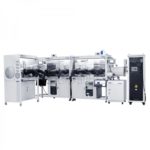With the promotion of new energy vehicles, environmentally friendly electric vehicles have become a new trend of energy saving and emission reduction for automobiles. Because of its high efficiency, safety and reliability, lithium-ion batteries are currently the world’s best comprehensive green batteries. The application fields of lithium-ion batteries will become more and more extensive. Lithium-ion batteries are composed of three parts: a battery cell, a protection circuit, and a case. The shell is divided into a shell and a cover. Insulation seals, gaskets, etc. need to be provided on the battery cover. Traditional battery covers are assembled manually by workers, and the cover marking, laser welding, CCD detection, cover film, and film bending are required. Each production process, such as cleaning fixtures, is equipped with a corresponding production line, which results in greater labor intensity, higher production costs, low production efficiency, and low assembly accuracy, which cannot meet the needs of large-scale battery production.
In order to solve the existing technical needs of manual assembly by workers, Etelux resulted in higher production costs, lower production efficiency and lower assembly accuracy. And provide a lithium battery automated production line.
The lithium battery automatic production line has the beneficial effect that the battery raw material package enters the glove box from the charging compartment, the battery raw material package is automatically scanned and weighed, the weighed battery raw material package is automatically placed in the material conveying device, and the conveying device automatically enters the liquid injection. The cylinder is filled with liquid, and the batteries after the filling are respectively placed in the stationary cylinders 1, 2, and 3, and are allowed to stand still. The batteries after the filling are placed in the sealed cylinders to be evacuated and sealed. The sealed batteries are automatically weighed twice. Heavy, unqualified products will enter the recycling transition cabin on the left for processing, and qualified batteries will be automatically sent to the discharge side cabin. The entire production process of the battery does not require manual intervention, which greatly reduces labor intensity and production costs. Make work efficiency significantly improved.


























